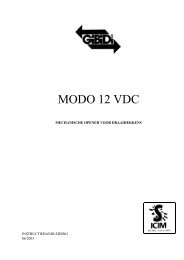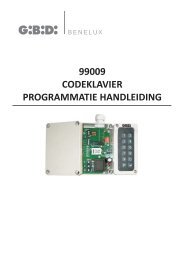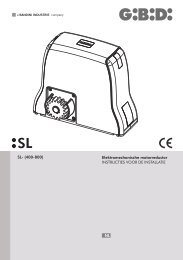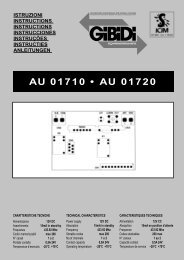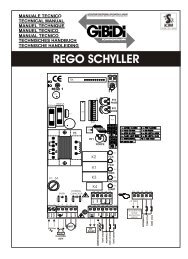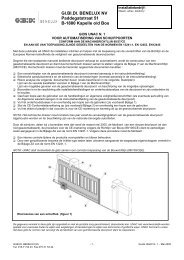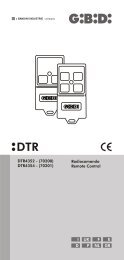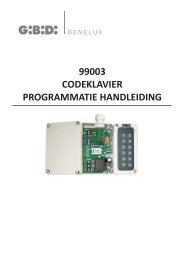Inductive Sensors Single or Dual Loop Detectors Type LD ... - GiBiDi
Inductive Sensors Single or Dual Loop Detectors Type LD ... - GiBiDi
Inductive Sensors Single or Dual Loop Detectors Type LD ... - GiBiDi
Create successful ePaper yourself
Turn your PDF publications into a flip-book with our unique Google optimized e-Paper software.
<strong>Inductive</strong> <strong>Sens<strong>or</strong>s</strong><br />
<strong>Single</strong> <strong>or</strong> <strong>Dual</strong> <strong>Loop</strong> Detect<strong>or</strong>s<br />
<strong>Type</strong> <strong>LD</strong> with teach-in<br />
• <strong>Single</strong> <strong>or</strong> <strong>Dual</strong> loop detect<strong>or</strong><br />
• Automatically adjustment of detection level<br />
• Manual sensitivity f<strong>or</strong> compensations of variations<br />
• Easy installation via 11 pin circular plug<br />
• Rated operational voltage:24 VAC/DC, 115 VAC <strong>or</strong><br />
230 VAC<br />
• Pulse <strong>or</strong> presence relay output<br />
• Output 1A/250 VAC SPDT relay<br />
• LED indication f<strong>or</strong> power, relay status and loop fault<br />
• Sensitivity boost – only <strong>LD</strong>P1<br />
• Selectable frequency – prevents cross-talk<br />
• Direction logic – only <strong>LD</strong>P2<br />
Product De scrip tion<br />
<strong>Loop</strong> detect<strong>or</strong>s f<strong>or</strong> detection<br />
of vehicles. The vehicle loop<br />
detect<strong>or</strong> is designed to handle<br />
all parking, drive-through and<br />
access control applications f<strong>or</strong><br />
controlling do<strong>or</strong>s, gates, barriers<br />
<strong>or</strong> fences.<br />
<strong>Type</strong> Selection<br />
The principle is based on a<br />
change in the inductance<br />
within the loop when a metallic<br />
object (vehicles) is passing.<br />
The microprocess<strong>or</strong> evaluates<br />
the changes.<br />
Ordering Key<br />
<strong>Type</strong><br />
Plug mounting<br />
<strong>Loop</strong> inputs<br />
Function<br />
Adjustment<br />
Outputs<br />
Relay versions<br />
Power supply<br />
<strong>LD</strong>P1 SA1 B 230<br />
Mounting Relay Ordering no. Ordering no. Ordering no.<br />
Supply: 24 VAC/DC Supply: 115 VAC Supply: 230 VAC<br />
<strong>Single</strong> loop SPDT <strong>LD</strong>P1SA1BM24 <strong>LD</strong>P1SA1B115 <strong>LD</strong>P1SA1B230<br />
<strong>Dual</strong> loop SPST <strong>LD</strong>P2TA2BM24 <strong>LD</strong>P2TA2B115 <strong>LD</strong>P2TA2B230<br />
Specifications<br />
Rated operational voltage (U B)<br />
Pin 2 & 1 230 195 to 265 VAC, 45 to 65 Hz<br />
115 98 to 132 VAC, 45 to 65 Hz<br />
M24 19.2 to 28.8 VAC/DC<br />
Rated insulation voltage 250’000 operations<br />
Sensitivity<br />
8 sensitivity settings available<br />
Frequency range<br />
13 - 120 kHz<br />
<strong>Loop</strong> inductance 15 - 1500 µH<br />
Operating frequency (f)<br />
Relay output<br />
1 HZ<br />
Response time<br />
400 mS<br />
Environment<br />
Overvoltage categ<strong>or</strong>y III (IEC 60664)<br />
Degree of protection IP 20 /IEC 60529, 60947-1)<br />
Pollution degree<br />
2 (IEC 60664/60664A,<br />
60947-1)<br />
Temperature<br />
Operating<br />
-40º to +70ºC (-40º to + 158ºF)<br />
St<strong>or</strong>age<br />
-50º to +85ºC (-58º to +185ºF)<br />
Housing material<br />
NORYL SE1, light grey<br />
Weight<br />
AC supply<br />
150 g<br />
AC/DC supply<br />
85 g<br />
Approvals<br />
UL508, CSA<br />
CE marking<br />
Yes<br />
Specifications are subject to change without notice (09.11.2005) 1
<strong>LD</strong>P<br />
Mode of Operation<br />
Application<br />
The <strong>LD</strong>P Vehicle <strong>Loop</strong><br />
Detect<strong>or</strong> is based on microprocess<strong>or</strong><br />
technology, which<br />
has enable a large number<br />
of functions to be implemented.<br />
The functions is primarily<br />
f<strong>or</strong> use in the Parking/Access<br />
Control Industry<br />
like control f<strong>or</strong> gates, barriers,<br />
fence,s etc.<br />
Standard operations is<br />
implemented including programmable<br />
pulse and presence<br />
option.<br />
Principle<br />
The Vehicle <strong>Loop</strong> Detect<strong>or</strong> is<br />
based on the inductive principle,<br />
using a coil of wire<br />
buried in the driveway and<br />
connected to the loop<br />
detect<strong>or</strong>.<br />
The change in inductance<br />
will be measured as a<br />
change in frequency.<br />
The output relay activates,<br />
when the loop is activated<br />
and releases again when the<br />
loop returns to a non-activated<br />
condition.<br />
Setup<br />
The loop has to be in a passive<br />
condition (no object in<br />
the loop area) during startup<br />
and adjustment.<br />
The loop detect<strong>or</strong> will automatically<br />
calibrate when the<br />
reset button has been activated,<br />
which will be indicated<br />
by the red LED flashing.<br />
The functioning can now be<br />
checked by activating the<br />
loop with the actual object.<br />
Now the yellow LED will go<br />
on, and the output relay will<br />
be activated acc<strong>or</strong>ding to<br />
the dip-switch settings.<br />
If the loop detect<strong>or</strong> does not<br />
react, the sensitivity must be<br />
manual adjusted by means<br />
of the dip-switches.<br />
Imp<strong>or</strong>tant: reset the system<br />
after changing the Dipswitch<br />
settings.<br />
Temperature compensation<br />
The frequency will increase<br />
as a result of decreasing<br />
temperatures and vice versa.<br />
To compensate f<strong>or</strong> this,<br />
<strong>or</strong> any other situation that<br />
courses slowly change in<br />
frequency, the <strong>LD</strong> auto tunes<br />
constantly. That means if the<br />
frequency changes slowly<br />
there will be no detection.<br />
The auto tune function compensates<br />
f<strong>or</strong> both increasing<br />
<strong>or</strong> decreasing in frequency.<br />
Fault detection<br />
This function is useful if the<br />
cable disconnect.<br />
The alarm will be indicated<br />
via the red LED in front of<br />
the housing. This LED is<br />
constantly lighting when the<br />
loop is open <strong>or</strong> to large and<br />
flashing when a sh<strong>or</strong>t circuit<br />
occurs <strong>or</strong> a loop is to small.<br />
<strong>Loop</strong> Under<br />
Roadway<br />
Sensitivity<br />
8 sensitivity settings are<br />
available on the dip-switches<br />
in front of the module, to<br />
allow flexibility in configuration<br />
and application (Compensation<br />
f<strong>or</strong> variation in<br />
loop construction).<br />
Reset switch<br />
The reset switch enables the<br />
detect<strong>or</strong> to be manually<br />
reset during commissioning<br />
and testing. The detect<strong>or</strong><br />
will re-tune the sensing loop<br />
and becoming ready f<strong>or</strong><br />
vehicle detection.<br />
Relay output<br />
The single loop detect<strong>or</strong> has<br />
two SPDT relays – one f<strong>or</strong><br />
pulse output and one f<strong>or</strong><br />
presence output.<br />
The dual loop detect<strong>or</strong> has<br />
two SPST relays – one f<strong>or</strong><br />
each loop.<br />
Pulse output (one shot): It is<br />
possible to select the length<br />
of the output period to 0.2s<br />
<strong>or</strong> 1 second. The pulse output<br />
can be setup to activate<br />
on detection of a vehicle <strong>or</strong><br />
when the vehicle leaves the<br />
loop.<br />
Presence output: The output<br />
will be activated as long as<br />
there is a vehicle parked in<br />
the loop. It will be possible to<br />
activate a filter (ON-delay of<br />
2 seconds), which prevents a<br />
false detection from a small<br />
<strong>or</strong> fast moving object.<br />
Pulse output mode<br />
The relay activates only f<strong>or</strong> a<br />
sh<strong>or</strong>t periode when the vehicle<br />
enters <strong>or</strong> leaves the loop.<br />
Permanent output mode<br />
The relay will remain active<br />
as long as there is a vehicle<br />
parked in the loop.<br />
Pulse length<br />
Extends the pulse length<br />
from 0.2 sec to 1 sec.<br />
On-delay<br />
Prevents false detections of<br />
small <strong>or</strong> fast moving objects.<br />
Sense boost (only single<br />
channel loop detect<strong>or</strong>)<br />
This feature sets the undetected<br />
level to maximum<br />
sensitivity and is used to<br />
prevent loss of detection of<br />
high-bed vehicles.<br />
Selectable frequency<br />
The frequency of the loop is<br />
determined by the inductance<br />
of the loop and the<br />
frequency switch setting. If<br />
the frequency switch is on,<br />
the frequency is reduced. It<br />
may be necessary to change<br />
the frequency to prevent<br />
cross talk between adjacent<br />
loops.<br />
The frequency function will<br />
only change the frequency<br />
of one channel of the dual<br />
loop detect<strong>or</strong>.<br />
Imp<strong>or</strong>tant: Be carefully<br />
when installing the detect<strong>or</strong><br />
next to another inductive<br />
load, as this can have an<br />
effect on the detect<strong>or</strong> and<br />
cause false detections.<br />
Operation Diagram<br />
Description <strong>Single</strong> Channel Detect<strong>or</strong> <strong>Dual</strong> Channel Detect<strong>or</strong> Comments<br />
Sense adjust Dip-switch 1,2,3 Dip-switch 1,2,3 8 levels<br />
Relay pulse output length Dip-switch 4 Dip-switch 4 0.2 <strong>or</strong> 1 second<br />
Relay pulse output mode Dip-switch 5 Dip-switch 5 Entering <strong>or</strong> leaving vehicle<br />
Relay output filter (on-delay) Dip-switch 6 Dip-switch 6 2 seconds<br />
Sense boost Dip-switch 7<br />
Change Frequency Dip-switch 8 Dip-switch 8 “Cross talk”<br />
Pulse relays/presence relays Dip-switch 7 2 functions<br />
2 Specifications are subject to change without notice (09.11.2005)
<strong>LD</strong>P<br />
Dip Switch Settings<br />
<strong>LD</strong>P1<br />
ON<br />
DIP switches<br />
1 Sense Level Select - MSB<br />
2 Sense Level Select<br />
3 Sense Level Select - LSB<br />
4 Pulse length 1 sec.<br />
4 Pulse length 0.2 sec.<br />
5 Pulse mode leaving<br />
5 Pulse mode entering<br />
6 On delay off<br />
6 On delay 2 sec.<br />
7 Sence boost Off<br />
7 Sence boost On<br />
8 Change Frq. Off<br />
8 Change Frq. On<br />
On<br />
<strong>LD</strong>P2<br />
ON<br />
DIP switches<br />
1<br />
2<br />
Sense Level Select - MSB<br />
Sense Level Select<br />
3 Sense Level Select - LSB<br />
4 Pulse length 1 sec.<br />
4 Pulse length 0.2 sec.<br />
5 Pulse mode leaving<br />
5 Pulse mode entering<br />
6 On delay off<br />
6 On delay 2 sec.<br />
7 Pulse mode<br />
7 Presence mode<br />
8 Change Frq. Off<br />
8 Change Frq. On<br />
Direction Logic<br />
5 Direction Logic<br />
7 Direction Logic<br />
On<br />
Imp<strong>or</strong>tant:<br />
Reset the detect<strong>or</strong><br />
after changing the<br />
Dip-switch settings<br />
Sensitivity adjustment<br />
Sense DIP1 DIP2 DIP3 Change in L<br />
Level (%)<br />
0 OFF OFF OFF 0.01<br />
1 OFF OFF ON 0.02<br />
2 OFF ON OFF 0.05<br />
3 OFF ON ON 0.1<br />
4 ON OFF OFF 0.2<br />
5 ON OFF ON 0.5<br />
6 ON ON OFF 1.0<br />
7 ON ON ON 2.0<br />
Direction logic<br />
Function<br />
The <strong>Dual</strong> loop detect<strong>or</strong><br />
(<strong>LD</strong>P2) is implemented with<br />
direction logic as standard.<br />
The function enables the<br />
detect<strong>or</strong> to give a pulse output<br />
on relay#1 f<strong>or</strong> a vehicle<br />
traveling from loop 1 to loop<br />
2 and a pulse output on<br />
Direction<br />
Relay 2<br />
relay#2 f<strong>or</strong> a vehicle traveling<br />
from loop 2 to loop 1.<br />
If a vehicle is detected, and<br />
the c<strong>or</strong>responding direction<br />
is indicated, both loops must<br />
be in a non-activated condition<br />
again bef<strong>or</strong>e the next<br />
object can be detected.<br />
<strong>Loop</strong> 1 <strong>Loop</strong> 2<br />
Relay 1<br />
Direction<br />
<strong>Loop</strong> Diagram<br />
<strong>Loop</strong> installation<br />
The loop geometry must be<br />
adapted to the respective<br />
application. The setup will be<br />
optimal if the loop has the<br />
same size as the object to be<br />
detected.<br />
After determing the loop<br />
geometry, a groove must be<br />
cut in the ground f<strong>or</strong> installing<br />
the loop.<br />
Cut an inclined groove of 45°<br />
angle at the c<strong>or</strong>ners of the<br />
loop, which will protect it from<br />
excessive wear.<br />
Clean the groove f<strong>or</strong> moisture<br />
and place the wire as tight as<br />
possible along the button of<br />
the groove.<br />
Bef<strong>or</strong>e sealing up the groove,<br />
it is recommandable to check<br />
the loop inductance using a<br />
measuring device. Optimum<br />
value: 80-300 µH.<br />
When sealing up the groove,<br />
ensure that the temperature of<br />
the sealing compound does<br />
not exceed the max temperature<br />
of the loop insulation, as<br />
this might cause an earth<br />
fault.<br />
<strong>Loop</strong> turns<br />
The number of turns strongly<br />
depends on the circumference<br />
of the loop. The smaller the<br />
loop, the m<strong>or</strong>e turns are<br />
required.<br />
Cable Recommandations<br />
- Use 1.5mm squared cable.<br />
Use silicon coated cable, if<br />
placed directly into the ground<br />
- Use 2m of spacing between<br />
two adjacent loops.<br />
- Use screened feeder cable in<br />
electrically noisy environments<br />
<strong>or</strong> where feeder runs parallel<br />
to power cables.<br />
Max depht into<br />
road: 50 mm<br />
Typical 30 mm<br />
<strong>Loop</strong> circumference No. of turns<br />
(m)<br />
>10 2<br />
6-10 3<br />
<br />
20 turns per meter<br />
max lenght: 20 m<br />
45°<br />
2 m<br />
1 m<br />
ROAD<br />
300 mm<br />
Specifications are subject to change without notice (09.11.2005) 3
<strong>LD</strong>P<br />
Pin configuration<br />
Pin n. <strong>Single</strong> Channel Detect<strong>or</strong> <strong>Dual</strong> Channel Detect<strong>or</strong><br />
1 Supply Supply<br />
2 Supply Supply<br />
3 Pulse relay NO NO <strong>Loop</strong> #1<br />
4 Pulse relay COM <strong>Loop</strong> #1<br />
5 Presence relay NO <strong>Loop</strong> #2<br />
6 Presence relay COM <strong>Loop</strong> #2<br />
7 <strong>Loop</strong> Pulse/Presence relay #2 NO<br />
8 <strong>Loop</strong> Pulse/Presence relay #2 COM<br />
9 Earth Earth<br />
10 Presence relay NC Pulse/Presence relay #1 NO<br />
11 Pulse relay NC Pulse/Presence relay #1 COM<br />
Dimension Drawing<br />
Wiring Diagram<br />
Plug version<br />
45<br />
<strong>LD</strong>P1<br />
<strong>Loop</strong> 1<br />
63<br />
μ<br />
11<br />
8<br />
9<br />
7<br />
10<br />
Pulse<br />
3<br />
5<br />
Pres<br />
21<br />
2<br />
4<br />
6<br />
1<br />
SUPPLY<br />
80<br />
<strong>LD</strong>P2<br />
35,5<br />
<strong>Loop</strong> 1 <strong>Loop</strong> 2<br />
μ<br />
3<br />
4<br />
9<br />
5<br />
6<br />
<strong>Loop</strong> 1<br />
10<br />
7<br />
<strong>Loop</strong> 2<br />
2<br />
11<br />
8<br />
1<br />
SUPPLY<br />
Access<strong>or</strong>ies<br />
Delivery Contents<br />
• 11 pole c<strong>or</strong>cular socket ZPD11 • Detect<strong>or</strong><br />
• Packaging: Carton box<br />
4 Specifications are subject to change without notice (09.11.2005)



